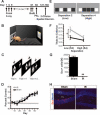A functional role for adult hippocampal neurogenesis in spatial pattern separation
- PMID: 19590004
- PMCID: PMC2997634
- DOI: 10.1126/science.1173215
A functional role for adult hippocampal neurogenesis in spatial pattern separation
Abstract
The dentate gyrus (DG) of the mammalian hippocampus is hypothesized to mediate pattern separation-the formation of distinct and orthogonal representations of mnemonic information-and also undergoes neurogenesis throughout life. How neurogenesis contributes to hippocampal function is largely unknown. Using adult mice in which hippocampal neurogenesis was ablated, we found specific impairments in spatial discrimination with two behavioral assays: (i) a spatial navigation radial arm maze task and (ii) a spatial, but non-navigable, task in the mouse touch screen. Mice with ablated neurogenesis were impaired when stimuli were presented with little spatial separation, but not when stimuli were more widely separated in space. Thus, newborn neurons may be necessary for normal pattern separation function in the DG of adult mice.
Figures



References
-
- Leutgeb JK, Leutgeb S, Moser MB, Moser EI. Science. 2007 Feb 16;315:961. - PubMed
-
- Nakashiba T, Young JZ, McHugh TJ, Buhl DL, Tonegawa S. Science. 2008 Feb 29;319:1260. - PubMed
-
- Marr D. Philos Trans R Soc Lond B Biol Sci. 1971 Jul 1;262:23. - PubMed
-
- Jung MW, McNaughton BL. Hippocampus. 1993 Apr;3:165. - PubMed
Publication types
MeSH terms
Grants and funding
LinkOut - more resources
Full Text Sources
Other Literature Sources
Medical

